|
Introduction:
Burma Army attacks remain frequent in the northern Karen State; shoot-on-sight killings and the destruction of crops remain the primary concern for those in hiding, and the subjugation and deliberate starvation of ethnic Karen villagers continues as the Burma Army attempts to consolidate its rule and squeeze displaced populations into areas it can control. Following attacks which displaced more than 30,000 people in northern Karen State between early 2006 and 2008, the Burma Army has slowed its offensive but has not eased in its ill-treatment of Burma’s ethnic minorities. Forced labor, extortion, theft and harassment are commonplace for villagers living under the Burma Army and these abuses are conducted with impunity.
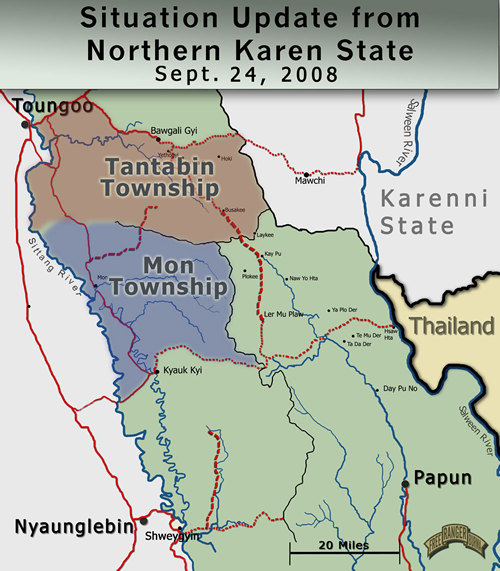 |
| Map of affected areas |
The following reports are only a sample of the numerous instances of Burma Army cruelty and exploitation which occur daily throughout Burma, including in areas under complete military control, those under attack and those in which the Burma Army is attempting to completely cut off interaction between villagers under its authority and those displaced and hiding in the mountains. Mon Township of Nyaunglebin District and Tan-tabin Township of Toungoo District, two of the areas covered in this report, are areas that have been especially targeted in the Burma Army’s offensive and rapid militarization since early 2006. Unless the Burma Army ceases its efforts to militarize and control these areas, abuses such as the murder, rape, starvation and displacement of those in hiding, and the severe oppression of those within its control, will continue.
Toungoo District:
Burma Army attacks against IDPs, and sweeps to locate and terrorize IDP populations and destroy their means of livelihood have increased in Toungoo District over the last several months. Designed to make life terrifying and impossible for people in hiding, the Burma Army hopes to brutalize these Karen villagers into submission, further solidifying its grip on power throughout Burma. While there have been few reports of villages being burned down in 2008, this is in large part due to the Burma Army’s large-scale attacks in 2006 and 2007 in which numerous villages were burned and thousands of villagers were forced into more remote, precarious and unsustainable situations. IDPs are now living in smaller groups, building more temporary housing structures, and must now venture further into areas recently occupied by Burma Army troops in order to cultivate and gather enough food for basic survival. This, along with a marked increase in Burma Army activity, has resulted in an increase in reports of villagers and families being surprised and attacked by Burma Army troops in their farms or gardens.
Burma Army Troops Shoot and Kill Two Villagers, Wound One and Capture Others; Burma Army Shelling Kills 15-year-old Boy and Wounds 14-year-old; 60-year-old Woman Killed by Burma Army Landmine
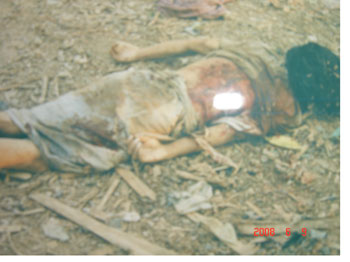 |
| Saw Da Cho Cho, shot by Burma Army, August 2008 |
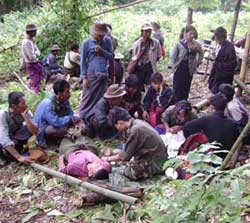 |
| FBR team provides medical treatment to IDPs in hiding. |
On 4 August 2008, soldiers from MOC 10 based in Bawgali Gyi were patrolling in the area between Bawgali Gyi and Ler Koh village when they spotted and immediately shot Saw Da Cho Cho, 38, a local villager who happened to be walking in the area. The troops shot him in the spine, he collapsed, and died soon after.
On 16 August, 2008, Burma Army troops captured Saw Dar Koe Ko, 50, from the area of Maw Pa Der village. Saw Dar Koe Ko was then killed sometime over the next several days as his body was later found by villagers on 20 August. It was not reported where his body was found or where exactly he was captured. The troops who killed him were from LIB 362, under Commander Thein Htun, from MOC 10.
Saw May Htoo, 15, was killed on 12 September when Burma Army troops shelled Klay Soe Kee village. That same day they also shelled into a nearby betel nut plantation and seriously injured Saw Da Boe Bo, 14. The troops are from MOC 10, LIB 364.
On 5 September, MOC 10 troops on patrol laid landmines in the Hsaw Wah Der area. Naw Say Paw, aged 60, had returned from her forced relocation site in the plains to check on her plantation and stepped on one of these mines; she was killed instantly.
On 7 June, 2008, the Burma Army attacked the area of Maung Nay Pwar, sweeping the area for people in hiding. One villager, Saw Nay Soe, was shot in the leg by the attacking troops, but managed to escape. The troops continued with the sweep after shooting him, but there were no further reports of wounded villagers. The attacking soldiers were from MOC 21.
LIB 368 also attacked around the same time in the area of Kaw Thay Der village. No casualties were reported, however the troops did burn down cardamom plantations belonging to local villagers. LIB 368 is under the command of Tin Ko Ko and is in TOC 3 of MOC 10.
On 24 June, four villagers, including Saw Mya Lay Htoo and Saw Commardo, were captured by the Burma Army in a betel nut plantation. While two of the villagers were subsequently released, Mya Lay Htoo and Commardo were taken to Tha Aye Hta camp. It has not yet been reported if they have been released.
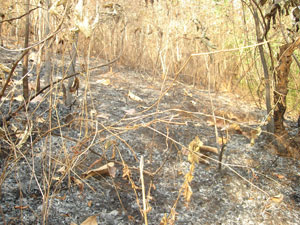 |
| Cardamom field burned by the Burma Army, June 2008. |
Forced labor and stolen food
Beginning on 7 August, 2008, Burma Army troops under MOC 10, stationed in Bawgali Gyi (Kler La) village, forced villagers who own vehicles to transport rocks from Toungoo Town to their camp in Bawgali Gyi. These vehicle owners were forced to make at least two trips per week during this period. At around the same time, each household in nearby Kaw Thay Der was also forced by troops under MOC 10 to cut seven lengths of bamboo for the Burma Army’s use in their local camp. Additionally, people from the villages of Kler La, Kaw Soe Ko, Kaw Thay Der, Wa Tho Ko, Ga Mu Der, Der Doh and Maw Koh Der were forced to make improvements to the local Burma Army camps.
Throughout this period, the Burma Army also halted all villager trade from Kler La to Toungoo. Villagers weren’t allowed to collect food in the mountains and sell their produce in Toungoo, including items such as durian fruit, mangosteens, and betel nut. This trade is a large part of the villagers’ income, and this denial of movement has caused a significant problem for a number of local residents.
On 13 September, 2008, Burma Army MOC troops blocked 200 villagers from the plains area from working on their fruit and cardamom plantations at Pa La Wah. MOC 10 is commanded by Ko Ko Hla.
On 3 September, Burma Army troops entered Kaw Tha Kaw village, stealing many of the villagers’ belongings. The local pastor was robbed of two baskets of rice, 400,000 kyat, one gold necklace and one ring. These troops were under the command of Kyaw Zay Ya.
On 2 September, 57 villagers were forced to carry supplies from the Burma Army’s camp at Play Hsa Lo to their new camp at Htee Pla Day. The villages included in the forced labor were Play Hsa Lo, Yaw Lo, Paung Pai, and Plaw Baw Der.
Nyaunglebin District:
Ler Doh Township: Villager executed for listening to radio
On 2 September, 2008, the SPDC fishery department demanded 100,000 kyat from each lake owner in the plains villages, purportedly for the purpose of helping cyclone recovery. Then, on 6 September, IB 60 commander Ko Ko Aung and IB 264 deputy battalion commander forced each lake owner to pay 50,000kyat for the battalion. The commanders also demanded 7 villages to give a new soldier, or pay 250,000 kyat. The villages are P’deh Gon, Thu Ka Bee, Noh Gaw, Wei La Daw, Pa Ta La, Aye Net, Tetu, and Le Wei Gyi.
On 15 September, Burma Army troops captured the lake owners who could not pay the money, all together 4 owners. They were sent to Tetu Burma Army camp. One of them was released, but another, Saw Oh Thi, was sent on to IB 60 battalion headquarters where he was accused additionally of listening to the radio and shot and killed by IB 60 Colonel Ko Ko Aung. It has not been reported whether the others have been released yet.
On 17 September, Ler Doh operation commander Colonel Soe Tha ordered that all farm and garden huts be destroyed, with no one allowed to live in their fields. At the same time, Div. 101 Lt. Gen. Maung Maung Oo ordered that all villagers stay out of the jungle or be killed. These sort of restrictions make it extremely difficult for villagers to harvest and/or forage enough food to survive.
Mon Township: Landmines, Forced Labor and Relocation, and Extortion
On 24 June, 2008, Saw Than Maung, from Maladaw village, stepped on a Burma Army landmine near Ta Kwey Lay Ko village. Burma Army landmines continue to pose a significant threat even to villagers living in areas under Burma Army control. Maladaw is one of the villages in northwestern Karen State that was attacked and designated as a forced relocation site by the Burma Army in April 2006. It is now home to a major new camp that has been the launching site of numerous attacks against villagers who remain in hiding.
Also on 24 June, Burma Army Lib 351 exchanged with LIB 387, under MOC 21. Then on 28 June the Burma Army sent 400 more troops to Tha Pyi Nyut camp, another relocation site and army camp established in 2006.
On 2 June, Tin Bo Aung, commander of LIB 599, began forcing villagers in the area of Kyaung Bya and Mya Taung to pay a tax for every farm hut they build in their fields. This edict seems to serve the dual purpose of creating additional income for the battalion, and also discourages villagers from working and staying in their fields. The Burma Army wants to control all villager movement so as to limit interaction between those in the plains and those hiding in the mountains. A number of plains villagers are now facing a severe shortage of food, partially as a result of this new tax, and some have chosen to abandon their fields in favour of finding alternative sources of income.
On 10 June, several Burma Army camp commanders under LIB 599 began demanding a tax of 100 kyat per bicycle travelling along the road from Mon Township to Kyauk Kyi Township. The commanders are Captain War Ga Na and Sergeant Myint Tin from Aung Lung Sein camp, and Sergeant Win Naing with Sergeant Htein Lin from Kyung Pin Zeik camp.
Also on 10 June, Soe Win, the secretary of Kyauk Kyi Township, demanded that every villager who owns a motorcycle shop must pay a tax of 5,000 kyat, any villager who owns land to build a house must pay 10,000 kyat and all other households must pay 2,500 kyat. Military commanders in areas throughout Burma continue to demand taxes from impoverished villagers despite the total lack of services provided by the Junta.
On 30 June, Burma Army Lib 599 forced villagers to stay in their villages following the defection and surrender to the KNLA of two Burma Army soldiers from LIB 439. The affected villages were Ta Kaw Pwa, Wai Swan, Nge Pwa Daw, War Do Klar, Ko Ni, Kyun Pin Zeik, No Nya La, Si Pa Ler, Haw Hta Plaw, Al Law Si and Shan Lay Si. Frequent restrictions on movement like this make farming and trade very difficult for people in these areas.
On 2 July, Burma Army LIB 590 forced villagers from Myaung Oo, Htee To Lo and Si Pin Tha villages to help build a Burma Army camp near Htee To Lo village. The orders came from Saw Moe Win, the battalion 2nd-in-command.
On 18 July, Burma Army Lib 590 demanded 50,000 kyat from Paung Zeik villagers and 50,000 kyat from Aung Chang Tha villagers. These troops are under the Paung Zeik camp commander Aung Win Htay.
On 19 July, the Myaung Oo camp commander Tun Win demanded 50,000 kyat from Myaung Oo village, 25,000 kyat from Paung Zeik villagers and 25,000 kyat from Aung Chan Tha villagers, making a total of another 100,000 kyat.
The following day, on 20 July 2008, LIB 590 battalion commander Ko Ko Oo demanded 75,000 kyat from Myaung Oo villagers, 75,000 kyat from Aung Chan Tha villagers, and 40,000 kyat from Kyauk Tan villagers, for an additional 190,000 Kyat.
Report from Kyaung Bya village, Mon Township: Villagers forced to vote for SPDC and arbitrary taxation
A Kyaung Bya villager recently reported that Burma Army abuses such as extortion and forced labor continue in the village. Burma Army Lib 599, which has set up a new camp near the village, demands 500 kyat every month per household to support the battalion with food. Every day they also force six villagers to work as security at the camp. During the recent referendum, despite the villagers’ desire to vote against the SPDC, the Burma Army forced villagers to vote for them. With the excuse of helping areas in the Delta affected by the cyclone, the camp commander has also demanded 10,000 kyat from each person with a television, 6,000 kyat from every farmer and 4,000 kyat from each widow.
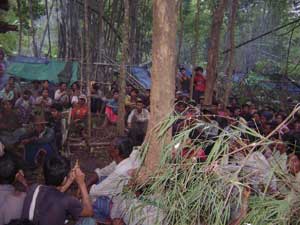 |
| Villagers from Kyaung Bya gather, 28 June, 2008 |
Interrogation and Forced Relocation after Villager Steps on Mine
On his way back from Kyauk Kyi, where he was interrogating a villager who stepped on a landmine, the commander of TOC 2 under the Burma Army’s Southern Command, Khin Maung Oo, stopped his car near Aung Soe Moe Burma Army camp and ordered the local camp commander, Mya Maung, to forcibly relocate Aung Soe Moe village. He demanded that the relocation must finish on 20 June, 2008, by 1200 hrs. The TOC commander said he did not want to see any villagers at Aung Soe Moe village and if he saw any villagers they would be shot. The villagers packed their clothes but did not know where to go. It has not yet been reported if the villagers have had to move again, but they were worried about the situation as their village had already been ordered to move twice in 2007 and once in 2008.
The mine victim, a villager from Kyaw Nger, stepped on a landmine in Kyaung Chay Thit Zone 4 in Mon Township. He had been to see a KNU officer to ask for a permit for gold mining within Zone 4. The KNU officer told him that this area was off limits, but the villager bought a machine and placed it in the area anyway, in the process stepping on a landmine. He was sent to the hospital in Kyauk Kyi to get medical treatment and while he was in the hospital the TOC commander came to see him. The commander was in the area for three days, 16-18 June, and asked him many questions about the circumstances of the incident.
On 22 August, 2008, one soldier from Burma Army MOC 21, LIB 276, defected to the KNLA. This came after a Burma Army corporal from LIB 387, patrolling in the Wah Kee areathe market area for villagers from the plains and mountain areasstepped on a landmine at Ka Moe Chi Kon village. As a result of this, Burma Army troops blocked the passage of the plains villagers to Wah Kee, thus shutting down local trade between the mountain and plains. This particularly affected villagers from Ka Wor Ko, Thet Baw Dor, Yaw Ke, Play Ke, Nwa Lay Ko, Ta Na Ta, Ka Pa Hta, Na Htee Ko, and Nya Mu Ke villages.
Earlier, on 2 July, LIB 590, No. 2 battalion commander, Saw Moe Win, forced villagers from Myaund Oo, Htee To Lo, and Si Bin Tha villages to build an army camp near Htee To Lo village. On July 27, LIB 590 commander Aung Win Oo forced villagers from Mi Tai Taw, Aung Chan Tha, and Paw Pi Dor villages to build a security hut and then take security for him.
Mon Township: 10 villagers6 women and 4 mencaptured by Burma Army
On 26 August, 2008, troops from MOC 21 captured 10 villagers who were gathering their harvest near old Kgo Pu village. Six of the captured villagers were women; the soldiers took them to Hsaw Me Le camp and then released them. The remaining 4 men they held at Muthe Camp until 2 September and then they released them. The villagers were from Kgo Pu and Hsaw Me Lu village.
Note: Burma Army no. 2 SOC commander, Col. Win Nyut, replaced Col. Khin Maung Oo on 20/8/08 at BA IB 60 camp at Tha Bo.
Hsaw Hti Township:
In Doo Pa Leh and Hti Bla villages there are 49 IDP families, with 299 people. There are two Burma Army camps in this area, one built this year and one relocated to Mayaw Ko. Burma Army Division 101 is stationed in this area with at least 3 battalions active in the area.
Last year, these villages were attacked and their rice harvest disrupted and they now do not have enough food. This is creating health problems: in seven days, the FBR team treated 95 people for health issues including malaria, acute respiratory infection, dysentery, and malnutrition. Additionally, because of the instability of the situation, the school is not in session regularly and the children receive little teaching.
Thaton District
Note: the above map does not include Thaton District, which is located directly south of the areas shown on the map, and north of Pa-an District.
During the month of August, Burma Army troops forced villagers from Noh Bah Baw village to cut 1000 lengths of bamboo to build up the Yo Klar Burma Army camp. The troops stationed at this camp are from MOC 19, IB 62. They are commanded by Hling Soe, with Kyaw Thu Ra as second-in-command. The troops demanded 500 lengths on 8 August, 100 on 19 August, and the last demand, for 400 lengths, came on 29 August, 2008.
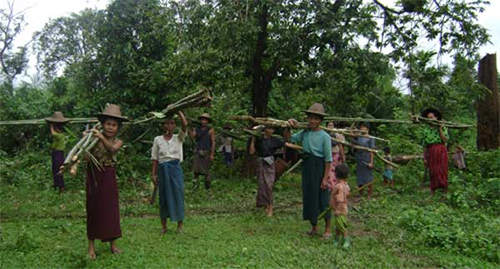 |
| Women from Thaton District forced to carry bamboo for Burma Army, August 2008. |
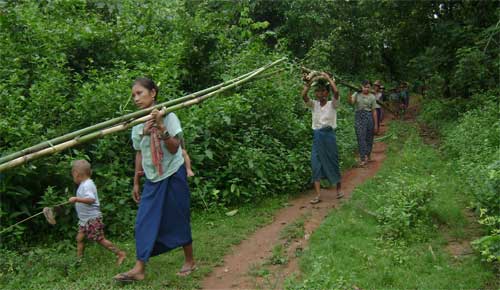 |
| Women with their children carrying bamboo for Burma Army camp, August 2008. |

